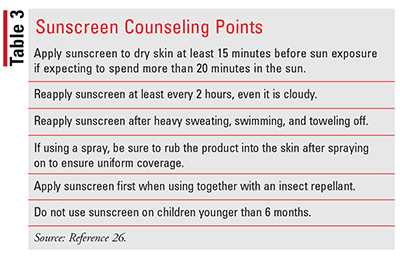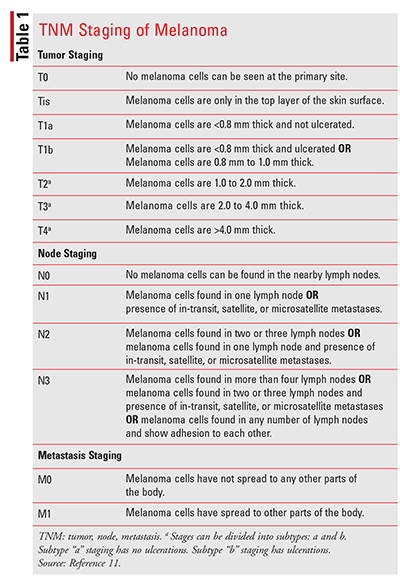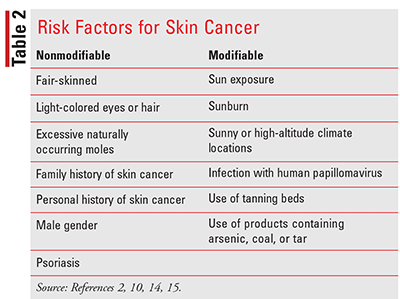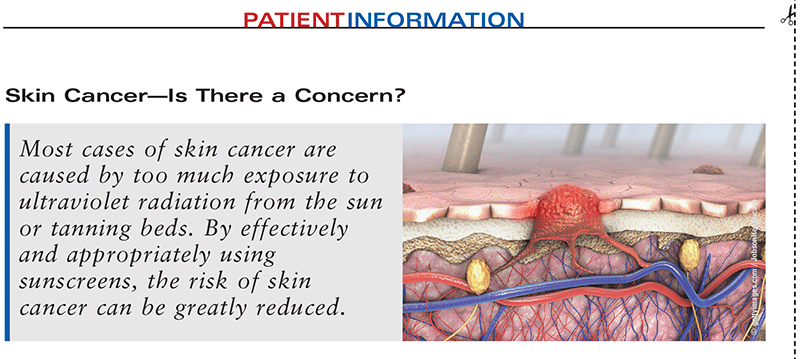US Pharm.2020;45(5)5-10.
Skin cancer is the most commonly diagnosed malignancy in the United States, with most cases considered preventable.1-3 The incidence of skin cancer has steadily been increasing. In the last three decades, incidence rates have risen five-fold.4 It has been estimated that one in five Americans will be diagnosed with skin cancer in their lifetime, with an estimated 9,500 newly diagnosed cases per day.5 Basal cell carcinoma, squamous cell carcinoma (also known as nonmelanoma skin cancer), and malignant melanoma are the most common types of skin cancer.
Nonmelanoma skin cancers (NMSC) are curable forms of skin cancer but are generally expensive to treat and can permanently damage the appearance of the skin. Basal cell carcinomas account for about 80% of all NMSC, while squamous cell carcinomas account for about 20%. In 2012, there were an estimated 5.4 million cases of NMSC diagnosed, although this number may underrepresent the true incidence; NMSC is not consistently reported to cancer registries.3,6 Research has indicated that the incidence of basal cell carcinoma and squamous cell carcinoma increased by 145% and 263%, respectively, between 1976-1984 and 2000-2010.7 The 5-year survival rates of basal cell carcinoma and squamous cell carcinoma are 100% and 90%, respectively.8 The high survival rate of NMSC is attributed to early detection and timely treatment. To maintain a good prognosis for high-risk NMSC patients, it is important to emphasize early detection.
Melanoma, on the other hand, has been noted to be more dangerous and have a greater risk of mortality. Although it accounts for about 1% of all skin cancer diagnoses, melanoma is responsible for the most skin cancer deaths, accounting for more than 9,000 deaths annually.1 However, from 2013 to 2017, melanoma-related deaths decreased by almost 6% in adults older than age 50 years and by 7% in those younger than age 50 years.9,10 Melanomas can be classified using the tumor, node, metastasis (TNM) staging system to differentiate the progression of the cancer (TABLE 1). Once TNM factors have been identified, a melanoma is assigned a stage ranging from stage 0 to stage IV. Stage I and II melanomas are localized, while stage III melanomas have regional lymph node involvement. Stage IV melanomas have distant metastasis.11 Approximately 85% of patients with melanoma will present with localized disease at the time of diagnosis. Regional disease accounts for almost 9% of patients at time of diagnosis, with distant disease accounting for an estimated 4%.12 As melanoma progresses through its various stages, the survival rates drastically decrease. The 5-year survival rate is dependent upon the stage of the melanoma at time of diagnosis. Patients diagnosed with localized disease have a 99% 5-year relative survival rate, while those diagnosed with regional disease have a 65% 5-year survival rate, and those with distant disease have a 25% 5-year survival rate.13 This decrease in survival rate illustrates the importance of early detection and treatment to prevent the progression of the cancer.
Risk Factors
There are many individual factors and determinants that may predispose a patient to skin cancer (TABLE 2). Certain genetic and familial characteristics such as skin type, eye color, or hair color may influence a patient’s risk; those with Fitzpatrick skin types I and II have the highest risk, as do those with blue, gray, or green eyes, and blond or red hair. Skin cancers also appear to occur more frequently in males; it is projected that in 2020 an estimated 60,190 cases of melanoma will be diagnosed in men compared with 20,160 women. Because skin cancer is highly associated with sun exposure, the incidence also increases with age; the median age of diagnosis for melanomas is about 60 years. The incidence of skin cancer also varies with ethnicity. The risk is 20 times greater for the white population than it is for populations with darker skin, including black, Indian/Alaska Native, Hispanic, and Asian/Pacific Islander populations. Family history and mole patterns, including changed or persistently changing moles, are additional risk factors for melanoma. Exposure to substances containing arsenic, coal, and tar, infection with human papillomavirus, immunosuppressive therapies, and chronic skin inflammatory diseases are known to warrant a risk for nonmelanoma cancers.2,10,14,15
The overwhelming majority of NMSC and melanomas, however, originate from overexposure to ultraviolet (UV) radiation, which damages the integrity of cells and results in the erratic formation of growths on the skin. Basal cell and squamous cell carcinomas both develop predominantly on areas such as the face, neck, ears, scalp, back, or hands, which is indicative of continuous exposure to the sun. Cumulatively, 90% of all NMSC are caused by UV radiation. Melanomas tend to develop as the result of intense, intermittent sun exposure that can lead to burning. This degree of exposure is usually caused by tanning beds and other artificial tanning methods using intense radiation.2,14,15
Clinical Presentations
The signs and symptoms of skin cancer differ based on the type of skin cancer; however, all skin cancers present initially as a skin abnormality. These abnormalities can occur as new skin pigmentation or moles on any part of the body or changes in an existing mole. Any unusual changes in the appearance of a skin abnormality should be evaluated by a dermatologist for further testing.16,17
Melanoma often presents initially as a skin abnormality with distinct characteristics or changes in appearance of an existing abnormality or mole. These changes can be identified using the “ABCDE” mnemonic: asymmetry, border, color, diameter, and evolving.15 The mole of a melanoma patient is often characterized as being asymmetric. The borders of the mole are uneven, blurred, or notched in appearance. The colors of these moles can range from shades of black, brown, and tan with areas of white, gray, red, or blue. Although the diameter of the mole may be smaller when detected early, melanoma moles can grow to a diameter of greater than 6 mm—the size of a pencil eraser. Lastly, existing moles changing size, shape, color, appearance, or texture can also be clinical presentations of melanoma. The mole can expand and encompass an area of healthy skin without symptoms of pain.16
Basal cell carcinomas usually develop in areas of skin that were exposed to the sun, most commonly in the head and neck region. Nodular basal cell carcinomas, representing almost 80% of cases, usually present as a pearly, waxy, or translucent papule with small telangiectatic vessels on its surface. Pigmented basal cell carcinoma usually has a nodular pattern and appears as a brown, blue, or black lesion, which is due to the presence of melanin; this nodule is often mistaken for melanoma. Superficial basal cell carcinomas most commonly occur on the trunk and usually present as slightly scaly macules, patches, or thin plaques that are light red to pink in color. The morpheaform type usually presents as a smooth, flesh-colored, or very light pink papule or plaque, often with indistinct borders.17
Squamous cell carcinoma can develop on any cutaneous surface including the trunk, extremities, oral mucosa, periungual skin, and anogenital areas, but it typically occurs on the head and neck, most frequently involving the lower lip, forehead, and scalp. Similar to basal cell carcinoma, squamous cell carcinoma may appear as a sore that does not heal or as a recurrent sore. It can also manifest as rough, scaly red patches with irregular borders, raised lumps with indentation in the center, wart-like growth, a crusty and easily bleeding sore, or an itchy/irritable growth.17
Prevention
Because most skin cancers are caused by overexposure to UV radiation, the most effective preventative measure is to decrease skin exposure to radiation. Some of these preventive methods include limiting or avoiding direct exposure to sunlight when the rays are strongest (10 am to 4 pm); avoiding sunbathing/sun lamps/tanning beds; wearing sun-protective clothing such as a wide-brimmed hat and long-sleeved shirts; and applying the appropriate sunscreen for optimal protection.18
The two most common types of UV radiation that contribute to the risk of skin cancer are UVA and UVB. UVA radiation has a longer wavelength and accounts for 95% of the UV radiation that reaches the earth’s surface. Although less intense compared with UVB radiation, UVA radiation is able to penetrate deeper into the skin, causing genetic cell damage that can lead to skin cancer in the epidermis, dermis, and hypodermis layers of the skin. UVA radiation is able to pass through glass and cloud cover, causing aging and/or wrinkling of the skin. Other sources of UVA radiation include tanning beds, which use UVA radiation to produce the tanning effect of the skin, thus putting users at a higher risk of developing skin cancer.19,20
Compared with UVA, UVB radiation has a shorter wavelength and is often filtered, due to its inability to pass through glass and cloud cover. UVB radiation is unable to penetrate deeper into the skin, exerting most of its damage on the epidermis and dermis layer of the skin. UVB exposure is often associated with skin burning and blistering (in severe cases). Unlike UVA radiation, UVB radiation’s intensity fluctuates based on the degree of intensity of the sun’s rays and can be avoided by limiting exposure to sunlight at its peak intensity. It is important to apply a broad-spectrum, water-resistant sunscreen prior to expected exposure to UV radiation.18-20
Selecting Sunscreens
Early sunscreen products protected the skin from UVB radiation only and not UVA radiation. However, after studies demonstrated the damage caused by UVA radiation, sunscreen manufacturers incorporated a broad-spectrum sunscreen to provide both UVB and UVA protection.21-23
The sun protection factor (SPF) of a sunscreen is a measurement of the sunscreen’s ability to protect the skin from UVB radiation, not UVA. Each SPF is a factor of the time it takes for an individual’s skin to redden (without sunscreen protection) upon constant exposure to UV radiation. For example, if it takes 15 minutes for a person’s skin to turn red upon continuous exposure to sunlight, applying an SPF 30 sunscreen allows the skin to be exposed for 450 (30 x 15 minutes) minutes before it starts to turn red from continuous sunlight exposure. By applying sunscreen prior to going out on a sunny day, the skin has an additional barrier that protects it from the harmful effects of UVB radiation. Sunscreens should be applied every 2 hours to maintain skin protection.21,22
In the past, some sunscreen products have been labeled as “waterproof.” This labeling implies that individuals using a waterproof sunscreen product would not need to reapply sunscreen after swimming or other contact with water or sweating. The FDA has prohibited the use of waterproof on sunscreen products because the term “overstated the effectiveness” of sunscreen upon exposure to water. However, sunscreen products can be labeled as water-resistant or very water-resistant, depending on the effectiveness of the ingredients in prolonging time to reapplication of sunscreen after exposure to water or sweat. A rating of 40 or 80 on water-resistant sunscreen products indicates the duration of effectiveness of the sunscreen while swimming or sweating. A rating of 40 indicates that the sunscreen is effective for 40 minutes while swimming or sweating, and should be reapplied after 40 minutes. “Very water-resistant” labeling is indicated with a rating of 80 and remains effective after 80 minutes of swimming or intense sweating. Sunscreen should be reapplied 40 to 80 minutes after swimming or sweating, or immediately after towel-drying.21,22
It is important to help patients select the right sunscreen product to provide the optimal barrier against UVA and UVB radiation in order to reduce the risk of skin cancer. Everyone should select a broad-spectrum sunscreen to provide protection against both types of harmful ultraviolet radiation. Individuals who have a fair complexion and are easily reddened upon exposure to sunlight should select a sunscreen product with an SPF 30 or higher. If a person expects to sweat throughout his or her activity or expects to swim, then he or she should select a sunscreen that is water-resistant or very water-resistant, depending on the length of the activity. For maximum protection, the American Academy of Dermatology recommends using a water-resistant, broad-spectrum sunscreen with an SPF of at least 30. Creams are best for dry skin and use on the face, while gels are good for hairy areas.23
Screening
Effective education about skin cancer and routine skin self-examination is crucial to preventing the progression of skin cancer, as most melanomas are detected in an early stage through self-screening. Most skin cancers present as a skin abnormality anywhere on the body, even in areas that were not exposed to the sun. Performing an examination of the common areas in which skin cancer can present, such as the face, scalp, trunk, torso, legs, and arms, with a full-length body mirror and a hand mirror allows for a thorough check on any new or unusual growth. Aside from the common body parts, individuals should also examine their fingernails, toenails, hands, toes, and mucosal membranes, because these are also locations in which new growth can occur. Any unusual or suspicious changes or new lesions on the skin or a sore that has not healed within 2 weeks should be reported to a healthcare provider or dermatologist for further evaluation.24,25
Role of the Pharmacist
Pharmacists have the opportunity to provide education about UV radiation, skin cancer, and modifiable risk factors, promote skin self-examination, encourage patients to reduce sun exposure, and assist patients with appropriate selection and use of sunscreen products (TABLE 3). When providing education to patients about skin cancer, pharmacists may evaluate patients and inform them of any risk factors they may have that would warrant concern regarding the risk of skin cancer. Pharmacists may also discuss the dangers of tanning, whether it involves prolonged exposure to natural sunlight or using a tanning bed. Such pharmacist-patient interactions enable patients to make more informed decisions regarding their sun exposure and using the right sunscreen to protect their skin.

Why should I be concerned about skin cancer?
Skin cancer can happen at any stage in life and affects both men and women. Approximately one in five Americans are expected to develop skin cancer in their lifetime. While nonmelanomas are generally treatable if detected early, melanomas are more dangerous. It is estimated that in 2020, there will be 100,350 cases of melanoma diagnosed in the United States with 6,850 people expected to die from it.
Who is at risk of getting skin cancer?
Genetic factors such as having lighter hair color, skin tone, or eyes may increase your risk of skin cancer. But most cases are caused by too much exposure to ultraviolet (UV) radiation from the sun or tanning beds. By effectively and appropriately using sunscreens that cover both UVA and UVB radiation with a sun-protection factor (SPF) of at least 15, the risk of developing skin cancer can be greatly reduced.
What are the symptoms of skin cancer?
The symptoms of skin cancer generally start with the development of a pigmentation or mole on the skin, or the change in color or structure of an existing mole. These abnormalities could also be painful, irritating, or begin to bleed. Any change in color, structure, or integrity of the skin that does not improve on its own should be evaluated by a dermatologist.
Do I need to be screened for skin cancer?
Although a diagnosis of skin cancer requires screening, screening processes are simple and only require the identification of an unusual or uncomfortable abnormality of the skin. It is recommended that individuals perform annual self-examinations to identify the presence of any new marks or pigmentations that could be cancerous.
Are there different screening tests?
To screen for skin cancer, you should first perform a self-examination of your entire body and look for any abnormalities. You can conduct a self-examination at home using a full-body mirror to examine any unusual or new formations of the skin, and a hand mirror for locations that are not easily visible. If a notable growth is identified, you should speak to your dermatologist about further screening. A dermatologist will likely examine the suspected growth, and possibly perform a biopsy or dermoscopy for further analysis.
Where can I learn more about skin cancer?
For additional information about skin cancer and other resources, visit the American Cancer Society website (www.cancer.org/cancer/skin-cancer.html) and the CDC (www.cdc.gov/cancer/skin/index.htm) to learn more.
REFERENCES
1. Guy GP Jr, Thomas CC, Thompson T, et al. Vital signs: melanoma incidence and mortality trends and projections—United States, 1982-2030. MMWR Morb Mortal Wkly Rep. 2015;64(21):591-596.
2. U.S. Department of Health and Human Services. Skin Cancer as a Major Public Health Problem. Washington, DC: Office of the Surgeon General; 2014. www.ncbi.nlm.nih.gov/books/NBK247164/. Accessed April 9, 2020.
3. Cancer Facts & Figures 2020. American Cancer Society. 2020:76. www.cancer.org/content/dam/cancer-org/research/cancer-facts-and-statistics/annual-cancer-facts-and-figures/2020/cancer-facts-and-figures-2020.pdf. Accessed April 22, 2020.
4. Leiter U, Eigentler T, Garbe C. Epidemiology of skin cancer. Adv Exp Med Biol. 2014;810:120-140.
5. American Academy of Dermatology. Skin cancer. www.aad.org/media/stats-skin-cancer. Accessed April 9, 2020.
6. Rogers HW, Weinstock MA, Harris AR, et al. Incidence estimate of nonmelanoma skin cancer in the United States, 2006. Arch Dermatol. 2010;146(3):283-287.
7. Muzic JG, Schmitt AR, Wright AC, et al. Incidence and trends of basal cell carcinoma and cutaneous squamous cell carcinoma: a population-based study in Olmsted county, Minnesota, 2000 to 2010. Mayo Clin Proc. 2017;92(6):890-898.
8. Rees JR, Zens MS, Celaya MO, et al. Survival after squamous cell and basal cell carcinoma of the skin: a retrospective cohort analysis. Int J Cancer. 2015;137(4):878-884.
9. Melanoma: Statistics. Cancer.Net. www.cancer.net/cancer-types/melanoma/statistics. Accessed April 9, 2020.
10. Siegel RL, Miller KD, Jemal A. Cancer statistics, 2020. CA Cancer J Clin. 2020;70(1):7-30.
11. Amin MB, Edge S, Greene F, et al, eds. AJCC Cancer Staging Manual. 8th ed. New York, NY: Springer International Publishing; 2017. www.springer.com/gp/book/9783319406176. Accessed April 9, 2020.
12. Clinical Practice Guidelines in Oncology: Cutaneous Melanoma. V 20AD. www.nccn.org/professionals/physician_gls/pdf/cutaneous_melanoma.pdf. Accessed April 9, 2020.
13. American Cancer Society. Survival rates for melanoma skin cancer. www.cancer.org/cancer/melanoma-skin-cancer/detection-diagnosis-staging/survival-rates-for-melanoma-skin-cancer-by-stage.html. Accessed April 9, 2020.
14. Fraser MC, Hartge P, Tucker MA. Melanoma and nonmelanoma skin cancer: epidemiology and risk factors. Semin Oncol Nurs. 1991;7(1):2-12.
15. Apalla Z, Lallas A, Sotiriou E, et al. Epidemiological trends in skin cancer. Dermatol Pract Concept. 2017;7(2):1-6.
16. Ward WH, Lambreton F, Goel N, et al. Clinical presentation and staging of melanoma. In: Ward WH, Farma JM, eds. Cutaneous Melanoma: Etiology and Therapy. Brisbane, Australia: Codon Publications; 2017. www.ncbi.nlm.nih.gov/books/NBK481857/. Accessed April 9, 2020.
17. Firnhaber JM. Diagnosis and treatment of basal cell and squamous cell carcinoma. Am Fam Physician. 2012;86(2):161-168.
18. CDC. What can I do to reduce my risk of skin cancer? www.cdc.gov/cancer/skin/basic_info/prevention.htm. Accessed April 9, 2020.
19. Narayanan DL, Saladi RN, Fox JL. Ultraviolet radiation and skin cancer. Int J Dermatol. 2010;49(9):978-986.
20. Balk SJ; Council on Environmental Health Section on Dermatology. Ultraviolet radiation: a hazard to children and adolescents. Pediatrics. 2011;127(3):e791-e817.
21. American Academy of Dermatology. Sunscreen FAQs. www.aad.org/public/everyday-care/sun-protection/sunscreen-patients/sunscreen-faqs. Accessed April 9, 2020.
22. FDA. FDA announces new requirements for over-the-counter (OTC) sunscreen products marketed in the U.S. www.fda.gov/media/85172/download. Accessed April 9, 2020.
23. FDA. Labeling and effectiveness testing: sunscreen drug products for over-the-counter human use — small entity compliance guide. www.fda.gov/regulatory-information/search-fda-guidance-documents/labeling-and-effectiveness-testing-sunscreen-drug-products-over-counter-human-use-small-entity. Accessed April 9, 2020.
24. American Cancer Society. How to do a skin self-exam. www.cancer.org/healthy/be-safe-in-sun/skin-exams.html. Accessed April 9, 2020.
25. American Society of Clinical Oncology. Cancer.Net. Melanoma: screening. www.cancer.net/cancer-types/melanoma/screening. Accessed April 9, 2020.
26. American Pharmacists Association. The sun is almost here. What will you recommend? http://www.pharmacist.com/article/sun-almost-here-what-will-you-recommend. Accessed April 9, 2020.
The content contained in this article is for informational purposes only. The content is not intended to be a substitute for professional advice. Reliance on any information provided in this article is solely at your own risk.
To comment on this article, contact rdavidson@uspharmacist.com.








